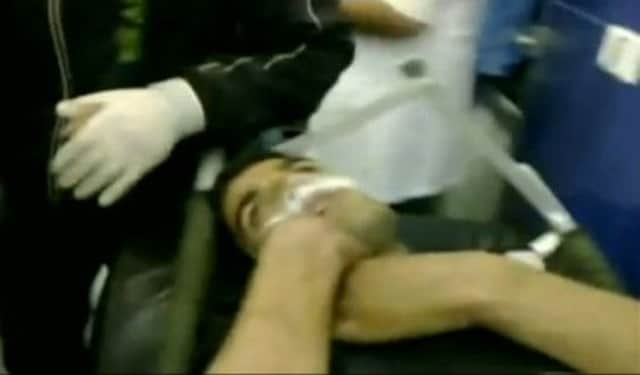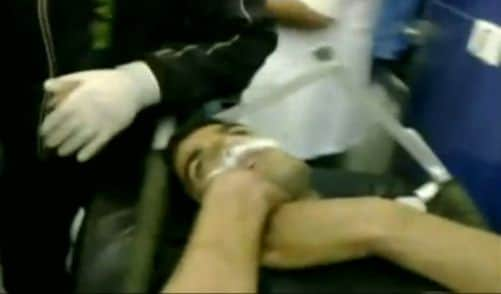Syria denies use of chemical weapons against rebels


SEE ALSO:


The White House said United States intelligence had concluded with “varying degrees of confidence” that the Syrian government has twice used chemicals, believed to include the deadly nerve agent sarin, in its battle against rebels trying to oust Assad.
And Prime Minister David Cameron said yesterday that “limited but growing evidence” that the weapons have been used in the civil war must spur the international community into doing more.
Advertisement
Hide AdAdvertisement
Hide AdHe described the US intelligence reports pointing to their use as “extremely serious” and said he had “always been keen for us to do more”.
However, in Damascus yesterday, a Syrian government official said Assad’s military “did not and will not use chemical weapons even if it had them”.
Instead, he accused opposition forces of using them in a March attack on the village of Khan al-Assal outside Aleppo, Syria’s largest city. The official said the Syrian army had no need to use chemical weapons because it can reach any area in Syria it wants without them.
His comments were echoed by Sharif Shehadeh, a Syrian politician, who said the army “can win the war with traditional weapons” and had no need for chemical weapons.
Syria’s official policy is not to confirm or deny it has chemical weapons.
Mr Shehadeh called the US claims “lies” and likened them to false accusations that Iraq possessed weapons of mass destruction – a claim the US had used to justify the invasion in 2003.
“What is being designed for Syria now is similar to what happened in Iraq, when Colin Powell lied in the Security Council and said Iraq possessed weapons of mass destruction prior to the US invasion and occupation of that country,” he said.
US president Barack Obama has said the use of chemical weapons would be a “red line” that could result in a significant military response. But the administration said yesterday the new revelation would not immediately change its stance.
Advertisement
Hide AdAdvertisement
Hide AdFollowing the Khan al-Assal attack, the government called for the UN to investigate alleged chemical weapons use by rebels.
Syria, however, has still not allowed a team of experts into the country, because it wants the investigation limited to the single incident, while UN secretary-general Ban Ki-moon is urging it to accept an expanded investigation into alleged chemical weapons use.
On the streets of Damascus, the conflict dragged on yesterday as government troops pushed into two northern districts, triggering heavy fighting with rebels as they tried to advance under air and artillery support, activists said.
The UK-based Syrian Observatory for Human Rights said the fighting between rebels and soldiers backed by pro-government militiamen was concentrated in the Jobar and Barzeh areas.
The Local Co-ordination Committees, another activist group, said troops also used mortars and multiple rocket launchers to bombard the nearby district of Qaboun.
The Syrian Arab news agency (Sana) said troops killed five rebels in clashes near the main mosque in Jobar.
The regime has largely kept the rebels at bay in Damascus, although opposition fighters control several suburbs, from which they have threatened the heart of the capital.
‘Poor man’s atomic bomb’ several times more lethal than cyanide
Advertisement
Hide AdAdvertisement
Hide AdInvented by five German scientists just before the outbreak of the Second World War, sarin was put into production during the war but was never used.
Made of four chemicals, including phosphorus trichloride, a drop of sarin is enough to kill a person by affecting signals to the nervous system. It has been called “the poor man’s atomic bomb”, a colourless and odourless substance several times more dangerous than cyanide.
It was traditionally used as a pesticide before its side-effects were discovered.
It is considered so toxic that even a tiny drop can be strong enough to cause fatal injuries. In liquid form, sarin can be used to poison food or water, while it can be equally lethal as a gas.
Those exposed to even mild doses can experience symptoms ranging from vomiting to paralysis, while long-term neurological damage can also appear.
Its use as a weapon has predominantly been in recent
decades. It is believed to have been used between 1983 and 1988 in the Iran-Iraq war. It was dropped on the Kurdish town of Halabja in March 1988 by Saddam Hussein’s forces, killing hundreds of civilians.
Sarin was also used by the Aum Shinrikyo doomsday group to kill seven people and injure 300 in Matsumoto, Japan, in 1994, and by cult members to kill 12 and injure thousands on the Tokyo underground in an
attack the following year.
Sarin was banned from production and stockpiling by the United Nations Chemical Weapons Convention in 1993 and all stockpiles were to have been destroyed by 2007.
(Tristan Stewart-Robertson)